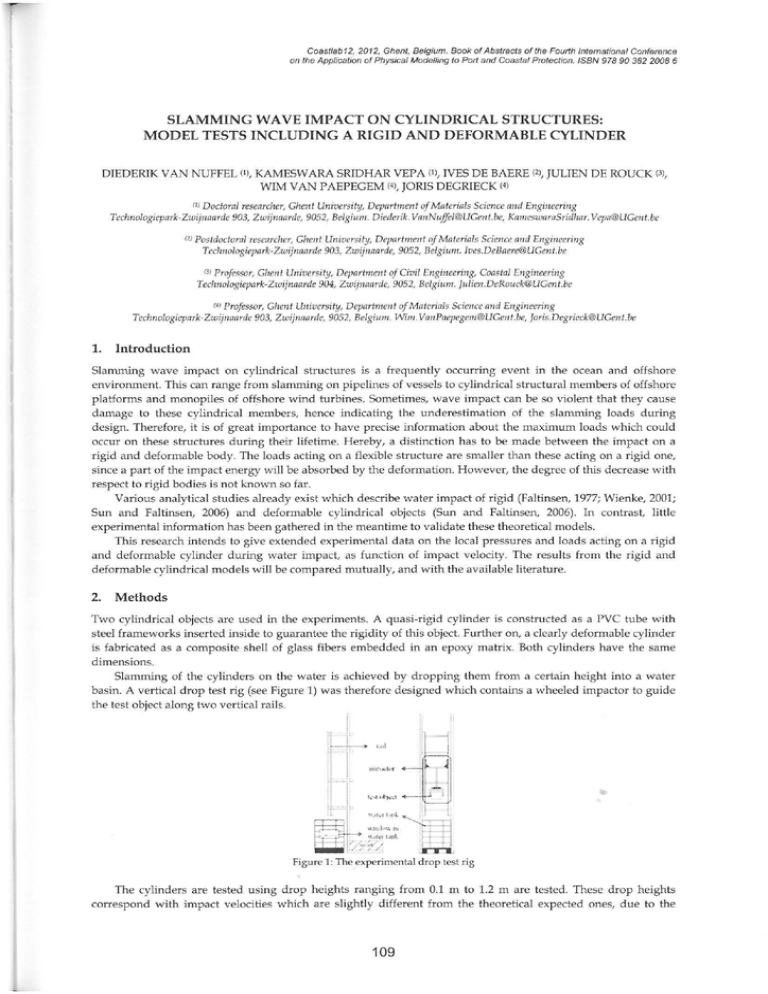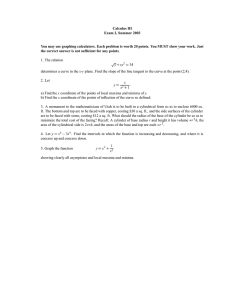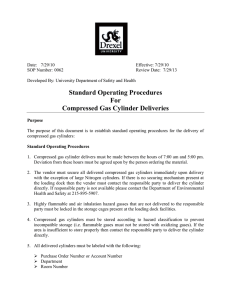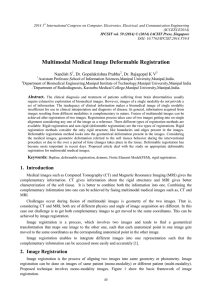Document 11770644
advertisement

Coast/ab 12, 2012, Ghent, Belgium. Book of Abstracts of the Fourth International Conference on the Application of Physical Modelling to Port and Coastal Protection. ISBN 978 90 382 2008 6 SLAMMING WAVE IMPACT ON CYLINDRICAL STRUCTURES: MODEL TESTS INCLUDING A RIGID AND DEFORMABLE CYLINDER DIEDERIK VAN NUFFEL (1), KAMESWARA SRIDHAR VEPA (1), IVES DE BA ERE (2), JULIEN DE ROUCK (3), WIM VAN P AEPEGEM (4J, JORIS DEGRIECK (4) O! Doctoral researcher, Ghent University, Department of Materials Science and Engineering Technologiepark-Zwijnaarde 903, Zwijnaarde, 9052, Belgium. Diederik. VanNuffel@UGent.be, KameswaraSridhar. Vepa@UGent.be m Postdoctoral researcher, Ghent University, Department of Materials Science and Engineering Technologiepark-Zwijnaarde 903, Zwijnaarde, 9052, Belgium. Ives.DeBaere@UGent.be (3! Professor, Ghent University, Department of Civil Engineering, Coastal Engineering Teclmologiepark-Zwijnaarde 904, Zwijnaarde, 9052, Belgium. Julien.DeRouck@UGent.be (4! Professor, Ghent University, Department of Materials Science and Engineering Technologiepark-Zwijnaarde 903, Zwijnaarde, 9052, Belgium. Wim. VanPaepegem@UGent.be, Joris.Degrieck@UGent.be 1. Introduction Slamming wave impact on cylindrical structures is a frequently occurring event in the ocean and offshore environment. This can range from slamming on pipelines of vessels to cylindrical structural members of offshore platforms and monopiles of offshore wind turbines. Sometimes, wave impact can be so violent that they cause damage to these cylindrical members, hence indicating the underestimation of the slamming loads during design. Therefore, it is of great importance to have precise information about the maximum loads which could occur on these structures during their lifetime. Hereby, a distinction has to be made between the impact on a rigid and deformable body. The loads acting on a flexible structure are smaller than these acting on a rigid one, since a part of the impact energy will be absorbed by the deformation. However, the degree of this decrease with respect to rigid bodies is not known so far. Various analytical studies already exist which describe water impact of rigid (Faltinsen, 1977; Wienke, 2001; Sun and Faltinsen, 2006) and deformable cylindrical objects (Sun and Faltinsen, 2006). In contrast, little experimental information has been gathered in the meantime to validate these theoretical models. This research intends to give extended experimental data on the local pressures and loads acting on a rigid and deformable cylinder during water impact, as function of impact velocity. The results from the rigid and deformable cylindrical models will be compared mutually, and with the available literature. 2. Methods Two cylindrical objects are used in the experiments. A quasi-rigid cylinder is constructed as a PVC tube with steel frameworks inserted inside to guarantee the rigidity of this object. Further on, a clearly deformable cylinder is fabricated as a composite shell of glass fibers embedded in an epoxy matrix. Both cylinders have the same dimensions. Slamming of the cylinders on the water is achieved by dropping them from a certain height into a water basin. A vertical drop test rig (see Figure 1) was therefore designed which contains a wheeled impactor to guide the test object along two vertical rails. Figure 1: The experimental drop test rig The cylinders are tested using drop heights ranging from 0.1 m to 1.2 m are tested. These drop heights correspond with impact velocities which are slightly different from the theoretical expected ones, due to the 109 friction between the impactor wheels and the vertical rails. The actual impact velocities are measured with a high speed camera using the Digital Image Correlation technique. The loads are measured during the experiments in two ways. Pressure sensors mounted at the surface of the cylinders at the bottom measure the local loads while the global forces are recorded by using three force sensors which are mounted above the cylind rical objects. 3. Results and conclusions When the loads acting on the cylinders are considered in the time domain, it can be observed that local an d global loads act on a complete different time basis (see Figure 2). While the local pressures pulses at the bottom of the cylinders occur only for a few hundred microseconds, the global force pulses last for 10 or 20 ms. Furthermore, the time at which the global forces reach their maximum value is relatively much later then the maximum of the local pressure at the bottom of the cylinders: these pressure pulses are already past when the global force is at its maximum. Force and pressure versus time 4000 10 ... ,, 3000 ,: \ , i \ g 2000 lL 1000JL' ~ ~ 0 / • I ~ ~ ,... - , \ ;' ~ 10 m 10 ; ' 0 J; -:- Impact pressure __ .._.. lmp.xt force , , ..-... \'\ .... _.,., ,,' >- < 20 30 Time(ms) s a::;: '-.. 0 40 Figure 2: Force and pressure acting on the rigid cylinder When considering the p eak values of the bottom pressures and forces, it can be observed that for both cylinder types these peaks rise non-linearly with impact velocity (see Figure 3). The relationship might be of second order or even higher. This explains why in heavy storms, where the waves reach velocities up to more than 10 m/s, impact loads can become so high that they induce damage. Furthermore, it can be noticed in Figure 3 that for both pressures and forces, the measured values for the flexible cylinder are smaller than these obtained for the rigid one. This indicates that part of the energy has been converted into deformation energy. For the forces, th e reduction rate is even higher than 50%. This observation illustrates the ability of flexible composite marine constructions to eliminate high stress peaks during slammin g wave impact. lmpacl pressure as function of impact velocity Rigid vs deformable Impact force as function of impact velocity Rigid vs d eformable 14000 20 .. ..:; o Deformable cylinder o;:- 8 .. • Rigid cylinder 15 :: ~ CL t> fl 10 CL .E 5 0 0 2 3 4 Impact velocity [m/s] Figure 3: Impact force and pressure as function of impact velocity for the rig id and deformable cylinder References Faltinsen O.M., 1977, 'Water impact loads and dynamic response of horizontal circular cylinders in offshore structures', Proc. of9tlr annual Offshore Technology Conference, p. 123- 191. Wienke J., 2001, 'Druckschlagbelastung auf schlanke zylindrische bauwerke durch brechende wellen', Technical University of Braunschweig, Germany. Sun H., O.M. Faltinsen, 2006, 'Water impact of horizontal circular cylinders and cylindrical shells', Applied Ocean Research, 28, 5, p. 299- 311. 110



